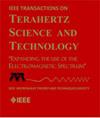SubTHz Fully-Metallic Geodesic Luneburg Lens Antenna
IF 3.9
2区 工程技术
Q2 ENGINEERING, ELECTRICAL & ELECTRONIC
IEEE Transactions on Terahertz Science and Technology
Pub Date : 2025-03-05
DOI:10.1109/TTHZ.2025.3548452
引用次数: 0
Abstract
We propose and validate experimentally a fully metallic geodesic Luneburg lens antenna operating in the subTHz band. The antenna produces three beams pointing at 0次太赫兹全金属测地线吕尼堡透镜天线
我们提出并实验验证了一种工作在亚太赫兹波段的全金属测地线吕尼堡透镜天线。天线产生三束指向0$^\circ$, 40$^\circ$和$- 40$^\circ$。为了便于整合,测地线透镜被折叠以降低其高度,约为原始莱因哈特-吕讷堡透镜的38.7%。为了减少在次太赫兹频率下制造和组装公差造成的潜在泄漏,波导馈电结构在电磁带隙结构旁边故意有一个小的气隙。这种增强的目的是加强天线的鲁棒性,即使在存在失调的情况下也能确保稳定的性能。结果证明了测地线透镜在亚太赫兹波段的鲁棒性;展示了它们在这些高频率下需要多波束天线的应用的适用性。测地线透镜在次太赫兹波段的成功表现证实了其在高于300 GHz的更高频率下工作的潜力。
本文章由计算机程序翻译,如有差异,请以英文原文为准。
求助全文
约1分钟内获得全文
求助全文
来源期刊

IEEE Transactions on Terahertz Science and Technology
ENGINEERING, ELECTRICAL & ELECTRONIC-OPTICS
CiteScore
7.10
自引率
9.40%
发文量
102
期刊介绍:
IEEE Transactions on Terahertz Science and Technology focuses on original research on Terahertz theory, techniques, and applications as they relate to components, devices, circuits, and systems involving the generation, transmission, and detection of Terahertz waves.
 求助内容:
求助内容: 应助结果提醒方式:
应助结果提醒方式:


